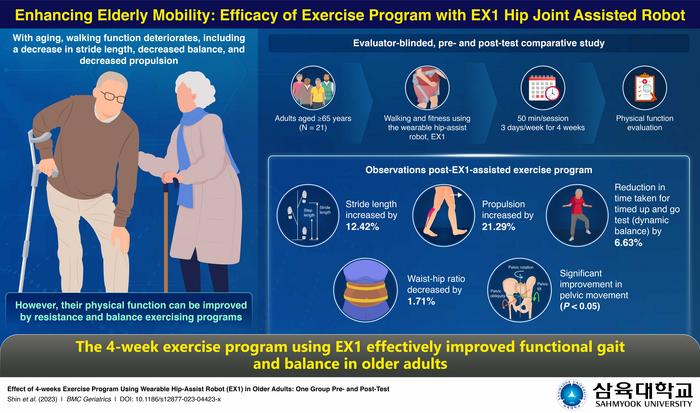The natural aging process often results in a notable reduction of muscle mass, particularly in the lower limbs. This decline, in turn, leads to a gradual decrease in physical activity among older adults, as the weakening of lower-limb muscles heightens the risk of falls. Fortunately, a strategic blend of aerobic and balancing exercises has the potential to not only enhance physical function but also mitigate the risk of falls in the elderly.

Credit: Wan‑hee Lee from Sahmyook University, Korea
The natural aging process often results in a notable reduction of muscle mass, particularly in the lower limbs. This decline, in turn, leads to a gradual decrease in physical activity among older adults, as the weakening of lower-limb muscles heightens the risk of falls. Fortunately, a strategic blend of aerobic and balancing exercises has the potential to not only enhance physical function but also mitigate the risk of falls in the elderly.
With the advancement of science and technology, robotics have infiltrated numerous sectors, including healthcare. Samsung Electronics Co., Ltd., (Suwon, Republic of Korea) has developed EX1, an exercise assistance robot, with the goal to amplify physical function and strength in senior individuals. This advanced robotic aid offers tailored workouts with both assistive and resistive modes, aiming to prevent falls and bolster overall health in this demographic.
Led by Professor Wan-hee Lee from Sahmyook University College of Health Science, Korea, a collaborative team of researchers, Noble County, and Samsung Electronics, assessed the effectiveness of EX1 in executing a four-week combined exercise program for older adults. Their study, published online on November 08, 2023, in BMC Geriatrics, unveiled significant findings regarding EX1’s role in enhancing exercise outcomes in this demographic.
Highlighting the importance of EX1, Prof. Lee explains, “Using the wearable robot EX1, older adults can effectively perform simple exercises such as walking and fitness, thereby improving their quality of life. EX1 can increase their participation in exercise and serve as a guideline for exercising the right way.”
The team designed an evaluator-blinded, pre- and post-test comparative study to analyze the effectiveness of EX1. A total of 21 older adults, aged 65 years or above, performed a supervised exercise program consisting of walking, and strength, and balance exercises, wearing EX1 for 50 minutes per session, thrice a week for four weeks. To compare pre- and post-exercise attributes, the spatiotemporal parameters, and pelvic movement were analyzed by G-Walk. Additionally, functional outcomes were evaluated by timed up and go test (TUG), muscle power by rehabilitative ultrasound imaging (RUSI), and waist-hip ratio by Inbody 770 (Biospace Inc., Seoul, Korea).
Following the exercise regimen, significant improvements were noted in various spatiotemporal factors: the stride length increased by 12.42%, whereas the propulsion increased by 21.29%, suggesting improved walking ability. The TUG test revealed a 6.63% decrease in completion time, indicating improved dynamic balance and expanded movement range among participants. Additionally, there was a notable 1.71% reduction in the waist-hip ratio after the four-week exercise period.
While the statistical significance of the increased walking speed wasn’t confirmed, a noticeable enhancement, especially during mid-walking, was attributed to the assistive mode of EX1. This mode notably improved stride length, affecting forward movement in straight walking. Moreover, pelvic movement in three planes significantly improved, aligning within normal ranges, fostering efficient walking by reducing energy consumption and bolstering stability through extended feet and a lower body center. The exercise program also positively impacted one-leg standing endurance, potentially due to strengthened hip-centered muscles crucial for fall prevention among older adults. Analysis of muscle activity revealed heightened activation of core muscles during walking, likely influenced by EX1’s waist support, contributing to trunk stability maintenance.
These findings suggest that although the 4-week exercise period was relatively short for older adults and did not notably enhance muscle strength, EX1 still displayed positive effects on improving gait function and balance ability in this population. “Our findings provide a solid foundation for developing various types of improved and advanced wearable robots. This will further expand the global wearable robot market, promoting further research and commercialization,” concludes an optimistic Prof. Lee.
***
Reference
Title of original paper: Effect of 4‑weeks exercise program using wearable hip‑assist robot (EX1) in older adults: one group pre‑ and post‑ test
Journal: BMC Geriatrics
DOI: https://doi.org/10.1186/s12877-023-04423-x
About the institute
Sahmyook University is situated in metropolitan Seoul, South Korea. The university is renowned for its pristine campus, earning the title of “Korea’s most beautiful university.” Its commitment to environmental sustainability is reflected in its eco-friendly construction. The university prides itself on its unique holistic academic counselling system in which students and professors organically work together in receiving and giving guidance. Comprising six colleges, including the College of Theology, Humanities & Social Science, and Health Science & Social Welfare, as well as four graduate schools, Sahmyook University provides a comprehensive educational experience.
Website: https://www.syu.ac.kr/eng/
About the author
Wan-hee Lee is a Professor of Dept of Physical Therapy, College of Health and Welfare at Sahmyook University, Korea. Alongside his research group, he is focused on investigating the effects of wearable robots. He has been studying walking assistance robots and systems in collaboration with ETRI and Samsung Electronics. Furthermore, his laboratory has also been exploring musculoskeletal physical therapy. He is an active release technique (ART) Korea host and is analyzing musculoskeletal treatment for the elderly and athletes. His research team is also investigating and developing rehabilitative ultrasound imaging (RUSI) for evidence-based treatment.
Journal
BMC Geriatrics
DOI
10.1186/s12877-023-04423-x
Method of Research
Experimental study
Subject of Research
People
Article Title
Effect of 4‑weeks exercise program using wearable hip‑assist robot (EX1) in older adults: one group pre‑ and post‑ test
Article Publication Date
8-Nov-2023
COI Statement
The authors declare no competing interests.




